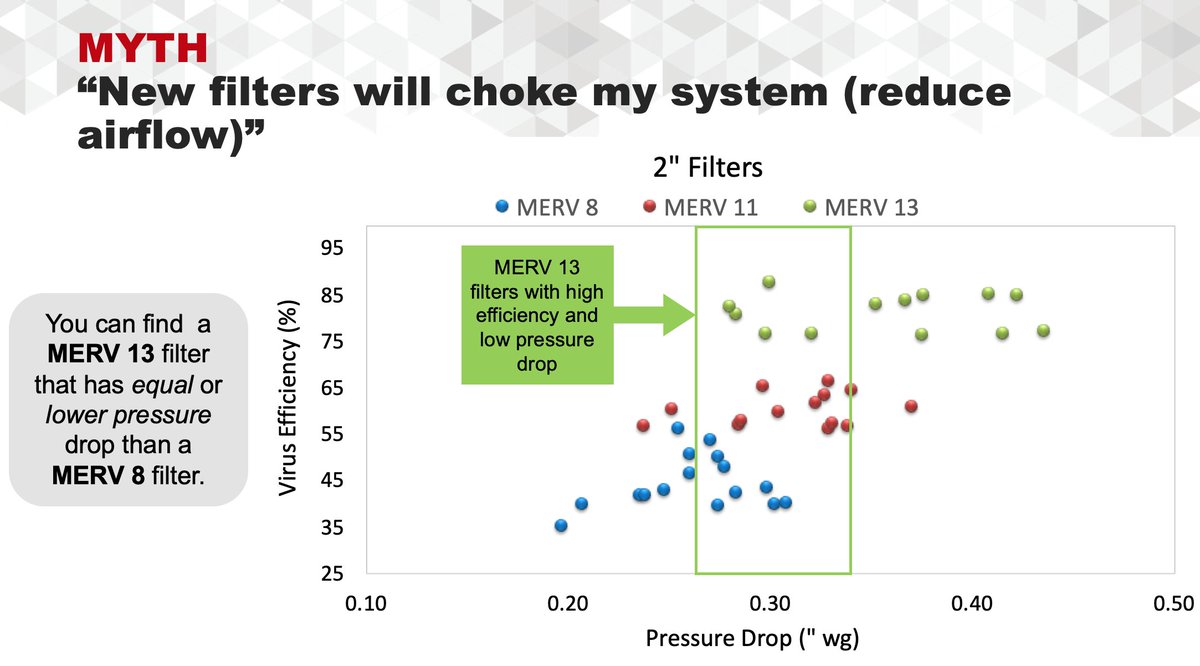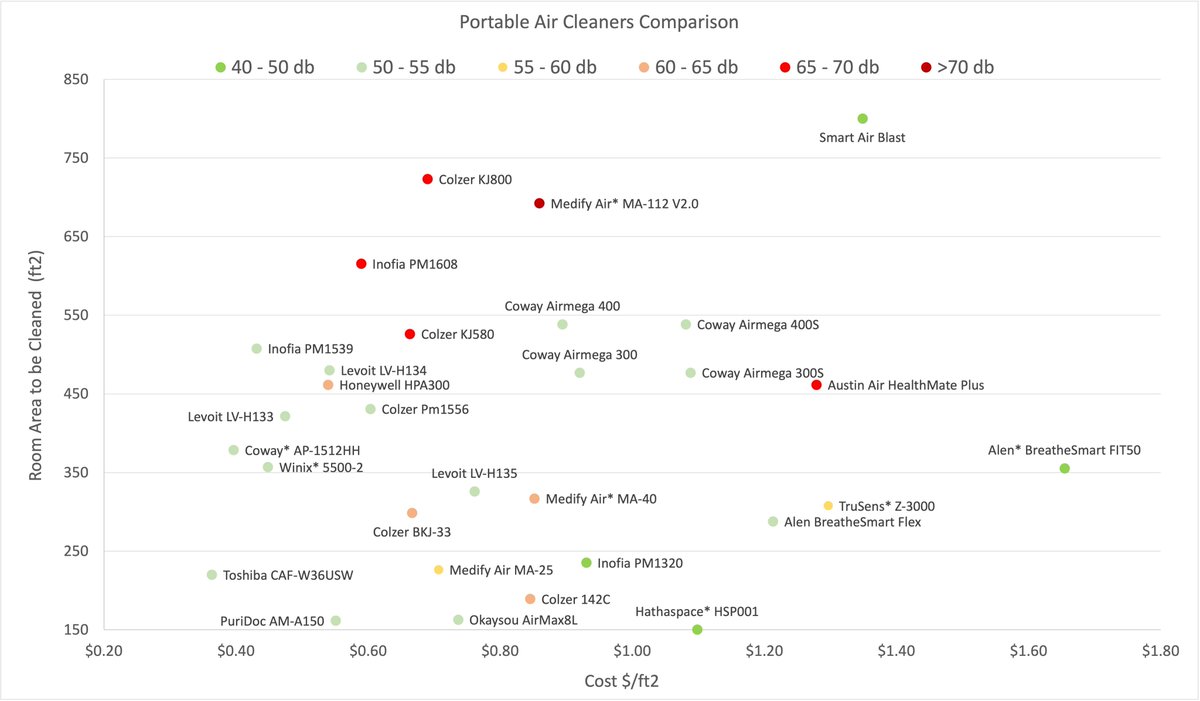
🧵I am going to expand on the first point from @don_milton. See @linseymarr tweet below.
-How to achieve 10 L/s/Person (22 CFM/person) of outside air
-What does it mean in terms of 3’ to 6’ social distance.
-How to achieve >4 ACH
-Myths regarding air cleaning
-How to achieve 10 L/s/Person (22 CFM/person) of outside air
-What does it mean in terms of 3’ to 6’ social distance.
-How to achieve >4 ACH
-Myths regarding air cleaning
https://twitter.com/linseymarr/status/1373362901684211723
Example used throughout the thread:
Classroom: 960 ft2
Specific dimension: 30' x 32'
Number of occupants: 30 (this is the design number, taking into account average classroom density - pre COVID)
Classroom: 960 ft2
Specific dimension: 30' x 32'
Number of occupants: 30 (this is the design number, taking into account average classroom density - pre COVID)
1) Ventilation
By code, this classroom would have 415 CFM of airflow of outside air. This airflow is being forced through the HVAC system (unit in classroom or mechanical room).
By code, when designed, every classroom in United States need to comply with this requirement.
By code, this classroom would have 415 CFM of airflow of outside air. This airflow is being forced through the HVAC system (unit in classroom or mechanical room).
By code, when designed, every classroom in United States need to comply with this requirement.
If we keep 6 ft distance --> we end up with 16 students, this means 12 l/s/person
If we reduce it to 3 ft -->we end up with 30 students (all kids will be back) --> 6 l/s/person

If we reduce it to 3 ft -->we end up with 30 students (all kids will be back) --> 6 l/s/person


The 3 ft social distance will NOT meet the requirement of 10 l/s/person of @Don_Milton and also WHO new guidance. Dr @CorsIAQ pointed to 2x occupancy impact 👇🏾 

and this is the BEST scenario in terms of outside air.
We know that schools are neglected and might not be able to meet the design outside airflow of 415 CFM, further exacerbating the issue.
We know that schools are neglected and might not be able to meet the design outside airflow of 415 CFM, further exacerbating the issue.
Opening windows: It will NOT work all the time.
Ventilation experts warn that “simply opening windows and doors without the use of exhaust fan, does not ensure adequate filtration – dependent on natural driving forces caused by the difference in temp wind speed."
Ventilation experts warn that “simply opening windows and doors without the use of exhaust fan, does not ensure adequate filtration – dependent on natural driving forces caused by the difference in temp wind speed."
ASHRAE Standard 62.1 (the Standard that sets ventilation rates adopted by almost all cities and states) has three pages of detailed guidance of how to design for natural ventilation (opening windows).
Opening windows should be the last resort.
This should NOT be an excuse of not doing the basics of checking how much outside air is available through the HVAC system.
First use of funds:
- Hire a test and balance company
- Perform maintenance to restore outside air CFM
This should NOT be an excuse of not doing the basics of checking how much outside air is available through the HVAC system.
First use of funds:
- Hire a test and balance company
- Perform maintenance to restore outside air CFM
2) Filtration:
All experts agree that filtration is a key strategy.
a) Mechanical filters (MERV) are the most basic and cost effective solution with an established Standards.
Two things:
- how efficient are MERV filters?
- how costly?
All experts agree that filtration is a key strategy.
a) Mechanical filters (MERV) are the most basic and cost effective solution with an established Standards.
Two things:
- how efficient are MERV filters?
- how costly?

Mechanical Filtration Efficiency:
Table from ASHRAE
MERV 8: 55%
MERV 11: 73%
MERV 13: 89%
Assume 0 OA:
MERV 13 will lead to 5 ACH
MERV 11 --> 4 ACH
MERV 8 --> 3 ACH
Table from ASHRAE
MERV 8: 55%
MERV 11: 73%
MERV 13: 89%
Assume 0 OA:
MERV 13 will lead to 5 ACH
MERV 11 --> 4 ACH
MERV 8 --> 3 ACH

Both MERV 11 and MERV 13 will meet @Don_Milton 4 ACH suggestion.
Second use of funds:
- assess what filtration efficiency you need to buy and purchase filters
Second use of funds:
- assess what filtration efficiency you need to buy and purchase filters
Mechanical Filtration cost:
Here is some good news...
The Yearly cost including two replacements of MERV 13 filters will be $28.
Let's assume it takes $5 of labor cost to install a filter.
Total cost per Year = $48
Please read this again. $48 to get >4 ACH.
Here is some good news...
The Yearly cost including two replacements of MERV 13 filters will be $28.
Let's assume it takes $5 of labor cost to install a filter.
Total cost per Year = $48
Please read this again. $48 to get >4 ACH.
Mechanical filtration myth:
Do NOT say that the HVAC system can not handle MERV 13. This is might be the case but it is unlikely to be TRUE.
Remember that also MERV 11 can be a good choice. This is backed by @ShellyMBoulder @MarcelHarmon1 and @JimRosenthal4
Do NOT say that the HVAC system can not handle MERV 13. This is might be the case but it is unlikely to be TRUE.
Remember that also MERV 11 can be a good choice. This is backed by @ShellyMBoulder @MarcelHarmon1 and @JimRosenthal4

b) UVGI
Read here by Dr. @WBahnfleth, one of the top experts.
As with everything else, UVGI needs to be well designed, installed, and maitained.
ashrae.org/file%20library…
Read here by Dr. @WBahnfleth, one of the top experts.
As with everything else, UVGI needs to be well designed, installed, and maitained.
ashrae.org/file%20library…

Do NOT confuse UVGI with UV-PCO:
- UVGI works by shining light on the air itself, thereby inactivating the virus.
- UV-PCO: UV is one of the component of Photocatalytic Oxidation technology. UV, in this case, will shine a light on a catalyst to produce oxygen species.
- UVGI works by shining light on the air itself, thereby inactivating the virus.
- UV-PCO: UV is one of the component of Photocatalytic Oxidation technology. UV, in this case, will shine a light on a catalyst to produce oxygen species.
Be aware of misleading product description.
One example of many.
Yes for UV cleaning the air.
NO for UV-PCO.

One example of many.
Yes for UV cleaning the air.
NO for UV-PCO.


c) Stand-alone air cleaners.
HEPA cleaners is the only proven technology: >99% efficiency to remove the virus.
Use in case you can NOT meet 4 ACH with filters + outside air.
For example: 0 outside air + no filtration -->
2x air cleaners of CADR = 350 --> will lead to 4.9 ACH.
HEPA cleaners is the only proven technology: >99% efficiency to remove the virus.
Use in case you can NOT meet 4 ACH with filters + outside air.
For example: 0 outside air + no filtration -->
2x air cleaners of CADR = 350 --> will lead to 4.9 ACH.

Be aware of false marketing:
HEPA-like
HEPA-style
99% HEPA
HEPAsilent
HEPA Ultra
Ionic HEPA
HEPAFast
HEPA Efficiency
HEPA Functions
HEPA Action
Plasma HEPA
Super HEPA
HyperHEPA
HELPA
HPEA
are ALL subpar versions of what constitutes a HEPA air filter.
Either HEPA or NOT HEPA
HEPA-like
HEPA-style
99% HEPA
HEPAsilent
HEPA Ultra
Ionic HEPA
HEPAFast
HEPA Efficiency
HEPA Functions
HEPA Action
Plasma HEPA
Super HEPA
HyperHEPA
HELPA
HPEA
are ALL subpar versions of what constitutes a HEPA air filter.
Either HEPA or NOT HEPA
Also be aware of CADR unit if it is in CFM or m3/hr. I had to return two devices twice after I figured this out.
For example, below CADR stated = 360. I assumed it is CFM. it turned out to in m3/hr, so CADR = 211 CFM.
For example, below CADR stated = 360. I assumed it is CFM. it turned out to in m3/hr, so CADR = 211 CFM.

Finally, say NO to ionizers:
https://twitter.com/marwa_zaatari/status/1359285590836060162?s=20
https://twitter.com/marwa_zaatari/status/1372039212170629120?s=20
https://twitter.com/marwa_zaatari/status/1371562055904473098?s=20
https://twitter.com/marwa_zaatari/status/1371488989778116610?s=20
https://twitter.com/marwa_zaatari/status/1358625462889627653?s=20
https://twitter.com/CorsIAQ/status/1370118525944176642?s=20
https://twitter.com/marwa_zaatari/status/1369427714751528970?s=20
• • •
Missing some Tweet in this thread? You can try to
force a refresh












